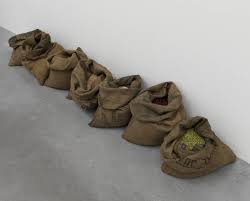The artist Jannis Kounellis, who was best known for his association with the Arte Povera movement has died in Rome, aged 80. Born in Piraeus, Greece in 1936, at the age of 20 he moved to Rome and studied at the Academy of Fine Arts, where he continued to live and work. His first solo exhibition in 1960 at La Tartaruga gallery exhibited 12 live horses. The work was recently recreated by New York’s Gavin Brown’s Enterprise in June 2015.
“A person can be beautiful in the morning and not be so in the afternoon”
“The Greeks used to say that beauty is like time; it changes: a person can be beautiful in the morning and not be so in the afternoon. A ‘form’ of beauty does not exist. Formalisation or clarity, on the other hand, are part of the family of beauty. Loving, too, is part of this family. If the Church says this, if it speaks of beauty in this sense, I favour of the Church. But if by beauty it means something else, I am opposed to it.” – Jannis Kounellis

In 1967, Kounellis joined the Arte Povera movement theorized by curator Germano Celant as a major shift from work on flat surfaces to installations. Kounellis participated in the exhibition ‘Arte Povera – e IM Spazio’ at the La Bertesca Gallery in Genoa curated by Germano Celant, which brought together artists whose work was concerned with the space between art and life, and nature and culture. Examples of artists who substantiated this basis of Arte Povera as a movement include Alighiero Boetti, Luciano Fabro, Giulio Paolini, Pino Pascali and Emilio Prini.
To solidify the movement, Germano Celant curated another group show, ‘Arte Povera’, which was exhibited at the De’ Foscherari gallery in Bologna in 1968 with similar artists; . In the same year Kounellis exhibited ‘Senza titolo (Untitled)’, which consisted of raw wool, rope and a wooden structure all leaning against a wall. Finally, Kounellis was also included in ‘RA3 Arte Povera + Azioni povere’ which was organized by Marcello Rumma and curated by Germano Celant.

Kounellis installed “live birds in cages along with rose-shaped, cloth cut-outs pinned to canvas” alongside his painting. Through this shift in his work, “Kounellis was more interested in anarchical freedom from linguistic norms and conventional materials. The space of the gallery and the exhibition site in general were transformed into a stage where real life and fiction could join in a suspension of disbelief.” The viewers became part of the scene of these living natural sources of energy within the gallery space. He continued his involvement with live animals later in 1969, when he exhibited twelve living horses, as if they were cars, in the Galleria l’Attico’s new location in an old garage in Via Beccaria. Gradually, Kounellis introduced new materials, such as propane torches, smoke, coal, meat, ground coffee, lead, and found wooden objects into his installations. He also looked beyond the gallery environment to historical (mostly industrial) sites. In 1997, Kounellis installed thirteen wardrobes and two doors that were sealed in lead along a scaffolding ledge that blocked the entry to a central hall. In 1968, in an interview by Marisa Volpi, Kounellis stated that incidental adjustments are certain as aspects that can indicate the human liberty of life
Kounellis used basic earthy materials in his work, coal, jute bags, steel, piles of stones, which tied him to the Arte Povera artists who used similarly “poor” media. The artist took part in the Venice Biennale for the first time in 1972 and became a regular contributor to the international exhibition. Over the years he has been the subject of solo exhibitions at international museums.
Top Photo: Jannis Kounellis Creative Commons Idra 338 Gabuchan

